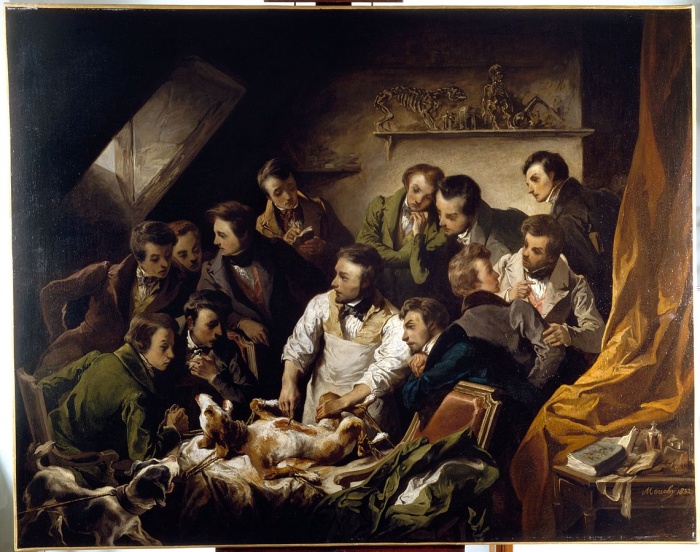
A physiological demonstration with vivisection of a dog, by Emile-Edouarda Mouchy'a, 1832. This file comes from Wellcome Images, a website operated by Wellcome Trust, a global charitable foundation based in the United Kingdom. Refer to Wellcome blog post. Library reference: Slide number 9033. Photo number: L0016546. Full Bibliographic Record: http://catalogue.wellcomelibrary.org/record=b1202391
1. A short history of non-human performers
Animal performance has a long history, going back to the beginnings of collections and spectacles in antiquity, through the first cabinets of curiosities to zoological gardens in the Renaissance era, through to natural history museums and the circus of the Enlightment. Animals also had a presence in the early TV shows. At the beginning of the 20th century, the participation of living creatures in the entertainment industry became controversial, although the debate on animal rights goes back to the end of the 17th century. Today, the history of non-human performers and their rights is being viewed in a much broader context, determined by the paradigm of class divisions and national identity, as well as post-colonial and gender1 studies.
Animals appear in artistic actions as metaphors of childhood, representations of trauma, or become erotic fetishes – both as animated objects and living creatures or ones immersed in eternal sleep, for which time has stopped, in better or worse shape thanks to taxidermy or simply in the form of rotting matter. On the one hand they become controversial works of art; on the other, they take over the role of performers or creators. We find animals in works by such artists as Mark Dion, Damien Hirst, Bruce Nauman, Robert Rauschenberg and Paul McCarthy, films of the General Idea collective, installations by Mike Kelley, or performances by Schneemann, Marina Abramović and many others.
The ambiguous role of animals in art has contributed to redefining such rudimentary concepts as the autonomy of gallery space or the role of the artist and the work of art. The artistic canon includes Salvador Dalí’s well-known Rainy Taxi (1938), filled with live snails, and Joseph Beuys’s performance I Love America and America Loves Me (1974), which took place in the René Block Gallery in New York, to which Beuys had been delivered by ambulance straight from the airport for a face-to-face encounter with a wild coyote. The artist spent three days in confrontation with the animal, entering simultaneously into the roles of activist artist and educator carrying out the policies of the American government towards the indigenous population of the continent. Animals were also used as protagonists by Jannis Kounellis, who in 1967 exhibited caged birds in an art gallery, and in 1969 brought into the white cube a dozen live horses. In 2006, animal activists were outraged by a live elephant that Banksy had painted as an advertisement for his first solo transatlantic exhibition.
What is the position of animals in the artworld today? Have they become liberated?
2. When zoology meets art
Congo was born in 1954. Between the ages of 2 and 4, he executed some 400 paintings in a style of lyrical abstraction; these were shown by the surrealist painter and zoologist Desmond Morris at the exhibition Paintings by Chimpanzees at London’s ICA in 1957. Morris, who had researched ape sensitivity, was famous for his TV show Zoo Time and as the author of the best-selling book The Naked Ape: A Zoologist’s Study of the Human Animal. His experiment with Congo evolved by chance: one day, the chimpanzee grabbed a pencil and drew a line. He then continued… For Morris, it became apparent that the chimp enjoyed drawing, so the artist sat the animal in a child’s chair and supplied him with paints, a brush and a canvas. Morris observed that the chimpanzee had colour preferences; some of his paintings displayed exceptional painterly sophistication and a sense of composition. According to Morris, Congo knew when the painting was complete; in spite of encouragement, he would not add a single brushstroke to a work once put aside. For the artworld, this was an eccentric experiment with a return to the roots of art. Congo’s exhibition at the ICA caused heated emotions; the worry was that the show could ruin the reputation of the gallery. On the day of the opening, Desmond Morris gave a lecture, based on his publication The Biology of Art, to provide an academic foundation for the exhibition. Congo’s paintings found their way into collections including those of Joan Miró and Picasso. The chimpanzee was happy to paint in front of the camera, and quickly became the star of the TV show Zoo Time.2 Today, a google search for ‘animal-made art’ throws up numerous examples of paintings created by animals. Many artists have attempted to repeat the artistic-cum-commercial success of Morris’s experiment with Congo. There are works created by elephants – which are said to have a great feel for composition – as well as rabbits and dolphins, which control the brush with their mouths. Nor is the brush the only artistic tool that animals have learnt to put to its accustomed use.
3. Monkey selfie
In 2011, David Slater was travelling on the Indonesian island of Sulawesi, taking shots of troops of macaques. Within a few days, with the help of a local guide, the British nature photographer gained their complete trust. The monkeys ‘befriended us and showed us absolutely no aggression – they were just interested in the things I was carrying’, reminisced Slater.3 After he had placed the camera on the tripod, the macaques spontaneously began to press the shutter. The photographer relates that the process was not straight-forward and required some insight into the animals’ behavioural patterns; for example, he had to persuade the monkeys to pose with their eyes open. The photographs from the ape session quickly went viral online, and Slater made a few thousand pounds. In 2014, the photographer asked Wikipedia and Techdirt to stop reproducing them without permission, but the sites refused on the grounds that the images were not subject to copyright, since they had been taken by animals. The matter went to court, which found in favour of Wikipedia. In 2015, PETA, People for the Ethical Treatment of Animals, took the matter before the courts again, this time on behalf of the macaque Naruto, whom they had supposedly recognised in the shots, and against David Slater. PETA’s case was that the monkey owned the copyright of the images that he had taken. The judges posed the questions: Can Naruto handle money? Does a monkey have a right to the privacy of his image? Neither Slater nor the macaque were found to own the copyright. The photographs remained in the public domain.
STOP PRESS
As we go online, the photographer David J. Slater has just won his court case, following his two-year legal battle with the organisation PETA, People for the Ethical Treatment of Animals, whose position was that the copyright of the monkey selfies taken by the macaque Naruto in the Indonesian jungle belonged to the animal rather than to the human photographer. 4
A joint statement from Peta and David Slater said that the photographer would give a quarter of the funds he received from selling the monkey selfies to registered charities ‘dedicated to protecting the welfare and habitat of Naruto’.
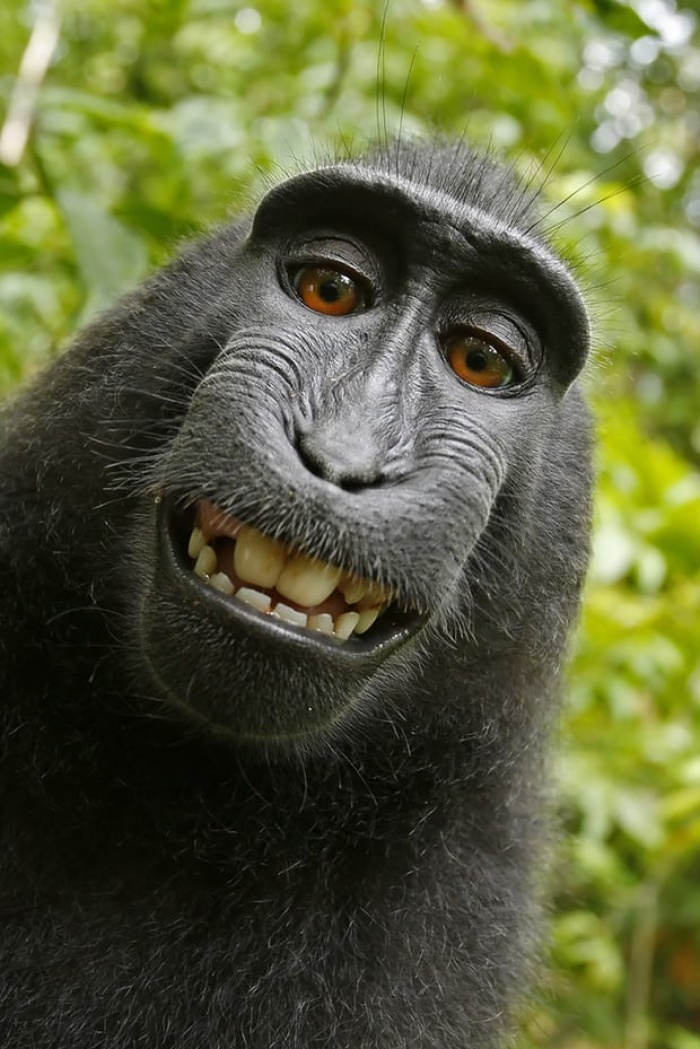
Małpie selfie, 2011. Zdjęcie: David Slater, źródło: (c) Carters News Agency
4. Gala
In 1994, Laura Lima brought a cow to the beach in Rio de Janeiro; since then, the Brazilian artist has used living creatures – people and animals – as the matter of her art. She often calls her works ‘paintings’, and their character and function often surprise and move visitors of art institutions.
In Le Viandier, the acclaimed mediaeval cookery book written by Guillaume Tirel which marks the beginning of French culinary art, there is a recipe for a royal dish of peacock. The aristocracy enjoyed eating the beautiful birds; Laura Lima chose to create a space where it was the birds that could eat royally. Her Pheasants with Food (2005) occasioned special unusual ceramics and dishes, prepared by the chef daily – with the difference that the restaurant was exclusively for animals. The viewers could do no more than ogle the spectacular avian feast, where the dishes served in a sophisticated manner evoked baroque ambiance.5 In her work Escape (2008), the artist gave the birds an opportunity to live unconstrained in the gallery space, which had been arranged for their convenience. The rooms were filled with constructions made of twigs, bird feeders, and even miniature copies of classical paintings. The visitors were intruders in the world of animals.6 This series of experiments with body and costume led Lima to the series Gala Chickens and Gala Coop, an avian fashion parade and carnival parade vibrant with colour. Popular breeds of chickens were lavishly decorated with artificial, multi-coloured feathers, glued on in the same way as human hair extensions. The change in plumage can lead to behavioural harmless aberrations. In the hands of the artist, the birds have become living sculptures; with a simple gesture, Lima is questioning fundamental artistic concepts such as the work of art or the performance.7
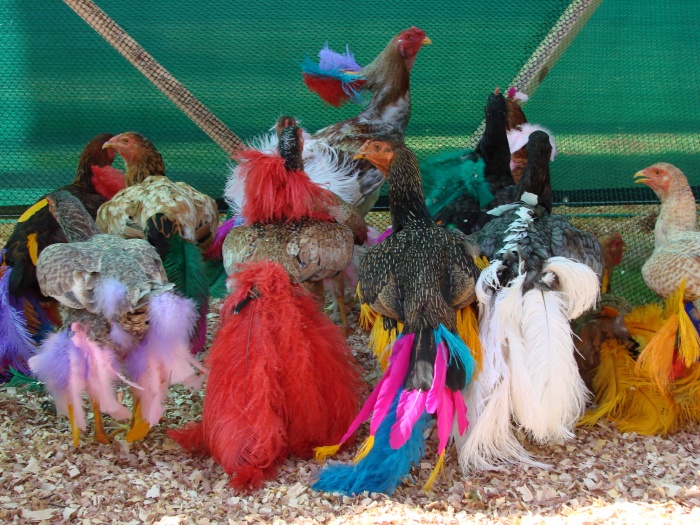
Gala Chickens, Laura Lima, 2007. (C) Cadu d'Oliveira. Dzięki uprzejmości artysty.
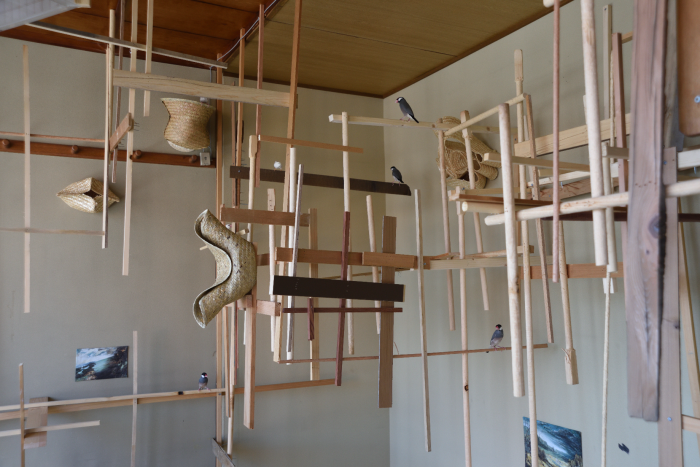
Escape, (c) Laura Lima, 2008. Dzięki uprzejmości artystki.
5. The world’s smallest performers
Maria Fernanda Cardoso from Columbia wanted to become a scientist, but she soon realised that as an artist she would be able to combine her investigative curiosity and creative zest. Cardoso is interested in both living and non-living matter and its significance. In her installations, she employs animal bones, emu feathers, sheep hides, and even preserved frogs or insect penises. One of the Columbian artist’s projects involved fleas, which proved particularly troublesome logistically. The insects were performers in her art project Cardoso Flea Circus (1994–2000). Fleas are the best jumpers in the world; the highly specialised construction of their hind legs enables them to make a few thousand leaps one after another, to a distance of some 50 times their body length. They cannot be trained; however, there are a few cruel tricks that force them into complicity on stage. Behind the captivating aesthetics of the mini circus, there lies a veritable theatre of cruelty. The flea circus, which has now disappeared from the popular imagination, is considered one of the least well-researched phenomena in the history of popular culture and animal performance. Performing fleas were first mentioned in 1578, but the first record of a flea circus dates back only to 1920, on the occasion of just such an event taking place in Regent Street in London; its Italian impresario Luis Bertolotto billed his show as an ‘extraordinary exhibition of industrious fleas’.
Flea circuses presented all sorts of spectacles – from juggling and tight-rope walking to concerts and reconstructions of Napoleonic battles. In her performance, Cardoso employed some of the techniques originally evolved by watchmakers, eager to demonstrate their metalworking skills. The fleas are placed in harnesses of fine wire, attaching the insects to various objects. This technique enabled the flea called Brutus, the protagonist of Cardoso’s performance, to pull a locomotive. With some staged flea action using historical costumes, juggling objects or musical instruments, the miniature props were often glued to the insect. The effect of dancing fleas was achieved by heating the small stage. Cardoso’s other actors were the ‘disappearing’ artist Harry Fleadini (named in homage to Harr Houdini), as well as Pipita and Pepon – a duo that performed a trick with a lit ball. Observing the tradition, after the performance at the Centre Pompidou Tipi (1998),8 Maria Fernanda Cardoso fed her performers with her own blood.
6. Human
‘Human’ is the name of a white bitch of the Podenco breed from Ibiza. With one of her legs painted pink, she appears together with the French artist Pierre Huyghe, whose art consists of ‘ecosystems’ with a symbiosis of nature and culture. Human has appeared in various spaces, specially prepared for her – with comfortable fur nests provided by galleries for her to lie in, and a friendly dog trainer to attend to the dog’s every need. The duration of her appearance at museums varies according to Human’s mood; she even has a private rest room. Viewers are asked not to stroke the dog. Human attended the dOCUMENTA (13) in Kassel (2012); 9 she could be seen in a nearby park, where there was an ant colony and a beehive, installed on the head of a stone sculpture of a female nude. In the fragile world where animals are the chief protagonists, subject to the natural laws of biology, the viewing protocol breaks down. For Pierre Huyghe, the exhibition is an object, scenery, a place where neither artist nor the spectator feels at home. The ‘ecosystem’ lives by its own rhythm, governed by randomness; the works often pass unnoticed or unobserved and some events occur just once. The artist calls a museum a ‘machine for viewing’; for him, an object is a ‘hysterical thing’ that ‘needs the gaze of a viewer in order to live’.10 The animals, which have been long present in Huyghe’s art bring an unusual dimension to his art works – which grow, move, appear and disappear. The living creatures do not perform but rather go about their daily activities such as building a hive, anthill or traps for flies. The artists comments that his works are ‘like a garden’.11
7. Work as a living creature
Termite mounds are made of earth mixed with timber and plants chewed up by the insects, as well as remnants of their faeces and saliva. These structures are incredibly durable and can even be up to 8–12 metres high. They provide these unusual insects with the stable temperature indispensable for their survival. The mounds made by African termites beat all height records. Like ants and bees, termites live in colonies that are complex social structures, and involve multi-level collaboration. In some circumstances, they can even make independent decisions, which affect the shape and complexity of the structure. Working closely with academics from Harvard University, Agnieszka Kurant set up a small ‘factory; of sculptures in Florida, made with the assistance of termites and shaped like the termite mounds to be seen in the natural world. The mounds, which are simultaneously a ‘living’ and ‘breathing’ installation, are built from coloured sand, gold and crystals. For the blind insects, it makes no difference what material they use in their constructions. For the artist, the work that the insects engage in is a metaphor of social relations, also relevant for the complex relations involved in the field of cultural production. Agnieszka Kurant is interested in the connections between magic and economy, and she questions the nature of authorship and a work of art as a living being. She also takes up the theme of the benign exploitation of animals and looks at the phenomenon of ‘playbor’, a made-up, portmanteau, American word coined from the combination of ‘play’ and ‘labor’, which refers to the online combination of playing and working as a single activity.
The paradox of the contemporary world, governed by digital economy, is that the two have become increasingly difficult to tell apart.
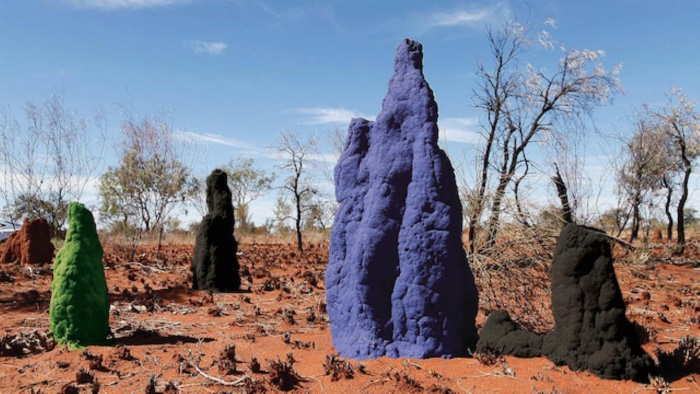
A.A.I, Agnieszka Kurant, 2014. Dzięki uprzejmości artystki.
8. The animal spirit in art
This May, the visual artist and performer Anne Imhof conquered the artworld with her performance, shown in the German pavilion at the Biennale in Venice. The dogs guarding the entrance to the building became performers in this contemporary interpretation of Doctor Faustus. In her actions, Imhof regularly uses non-human performers. Thus, animals not only become the chief protagonists of art works, but were also in a position to change the nature of the work by introducing an element of the ‘uncanny’ and frequently validated the artistic situation. Alongside the development of post-humanist thought and thanks to the performative turnaround in visual arts, completely new strategies and attitudes to living creatures have been born. One notes the different ways of viewing the body of a non-human performer, which can also stem from the fact that today we have a different understanding of the role of the viewer and audience participation in an artistic action. Throughout contemporary art, including the performing arts, all the traditional divisions – the work versus the audience, the audience versus the stage, the viewers and the performers – have become blurred.
The genesis of the complex thinking about the exhibition, work of art and artistic happening must be sought, i.a., in the praxis of relational artists, whre the concept was born of an art work as an ‘ecosystem’, a living installation, a hybrid object that is created in harmony between culture and nature.
Today, artists who work with animals, usually in the context of their exhibition programmes work closely with organisations that support animal rights. The living creatures that are part of artistic ecosystems often come from animal shelters (Human, the dog) or slaughter houses (Laura Lima’s animals) – places where animal suffering is rife. In her book Wild and Dangerous Performances: Animals, Emotions, Circuses (2011), Peta Tait talks about the cultural and emotional transformation that has taken place in the human perception of animals over the last decades; they are no longer treated as aesthetic or symbolic objects but rather as living creatures with which we share the Earth. Although cruel scenarios involving animals are today less prevalent, the process of their exploitation in the entertainment industry and in relation to artistic practice continues nevertheless unabated.
Translated from the Polish by Anda MacBride
BIO
Joanna Zielińska is a curator and contemporary performance researcher. She is interested in transdisciplinary artistic practice particularly the crossover between visual arts, theater and literature. In her practice she explores different formats in visual arts such as staged exhibition, the artist's novel or publication. She is the Head of the Performance Department at the Ujazdowski Castle Centre for Contemporary Art in Warsaw. She was a chief curator at the Centre for Documentation of the Art of Tadeusz Kantor – Cricoteka in Kraków. She is the former Program Director at Znaki Czasu Centre of Contemporary Art (CoCA) in Toruń, Poland. Currently, she is working on a long-term project on artist novels in collaboration with David Maroto called The Book Lovers. The central question of this research is how a literary genre such as the novel becomes a medium in the visual arts.
Cover photo: Laura Lima, Gala Chickens. Photo by Cadu d'Oliveira.
1Sina Najafi (ed.), Curiosity and Method. Ten Years of Cabinet Magazine, New York, 2012, p. 23.
2 https://www.ica.art/bulletin/last-living-surrealist-desmond-morris-paintings-chimpanzees-his-work-and-origins-ica, [date accessed: 10 September 2017].
3 https://www.theguardian.com/world/2011/jul/04/shutter-happy-monkey-photographer, [date accessed: 10 September 2017].
4 http://www.huffingtonpost.co.uk/entry/monkey-selfie-photographer-reaches-settlement-in-2-year-legal-battle_uk_59b7c4b0e4b027c149e24221 [date accessed: 12 September 2017].
5Laura Lima, Migros Museum, Bonniers Konsthall, JRP/Ringer, 2013, p. 54.
6Ibid, p. 34.
7Ibid, p. 61.
8 http://mariafernandacardoso.com/animal-art/cardoso-flea-circus-live-in-paris-2 [date accessed: 10 September 2017].
9 https://www.youtube.com/watch?v=xI9M5Juotnw; https://www.youtube.com/watch?v=j0V4Y94BkqA; https://www.youtube.com/watch?v=oKLtHMu-2aY [date accessed: 10 September 2017].
10 http://www.artinamericamagazine.com/news-features/interviews/let-the-light-in-pierre-huyghersquos-first-us-retrospective-comes-to-los-angeles/, [date accessed: 10 September 2017].
11http://unframed.lacma.org/2014/11/26/human-pierre-huyghe%E2%80%99s-dog-residence, [date accessed: 10 September 2017].



